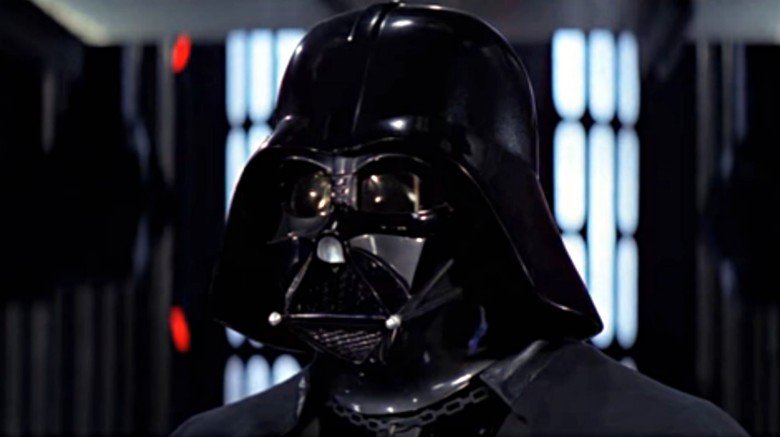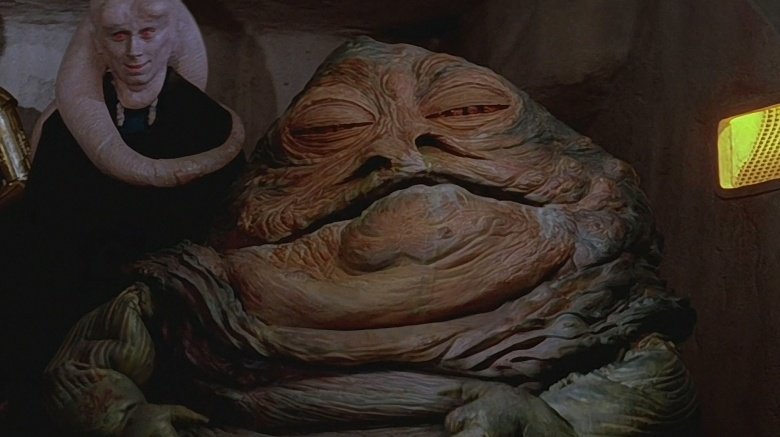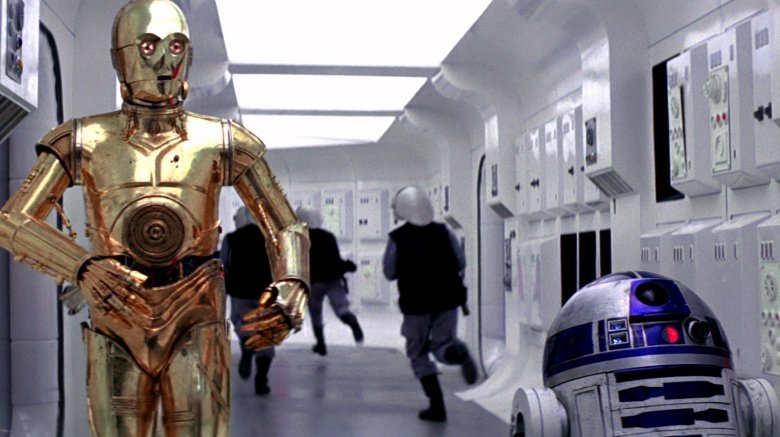Ways That Star Wars Characters Never Live Up To Their Hype
Star Wars has left a nearly immeasurable impact on pop culture. Religions have been exported from its stories to the real world, military programs have been named after it, and lines from Star Wars scripts are seen as inarguable wisdom. Thanks to a new slew of sequels and spinoffs, fan fervor for the franchise is stronger than ever.
If you closely at the films, however, something becomes clear: a lot of the foundations of the franchise's most beloved characters — and a lot of what we love about those characters — is just plain wrong. The wisdom of the Jedi, the indomitable will and power of the Sith, the incalculable threat of the evil Empire — when you pay attention to what actually happens in the stories versus how the characters sell themselves with their thick robes, their booming theme music, and their clever dialogue waiting to be made into cliché, they rarely live up to their reputations.
Not convinced? Read on for a look at just some of the ways Star Wars characters never live up to their hype.
Darth Loser
Darth Vader. He stops lasers with the palm of his hand and he rips the gun out of your grip with his mind. He is the absolute last person in the galaxy to whom you want to bring bad news. But how did he get his scary reputation — and did he ever really come close to living up to the hype?
Darth Vader mind-chokes lots of officers, he killed younglings who thought he was saving them, he decapitated Count Dooku, and he killed Obi-Wan. Vader is excellent at killing people who can't fight back. What's his record when he actually has a challenger?
He killed Dooku in the beginning of Revenge of the Sith. In A New Hope, he kind of beat Kenobi, but Kenobi was taking one for the team in order to let everyone else escape. In Empire Strikes Back, he defeated his son, who had five minutes of training on the Millennium Falcon and then 15 more with Yoda.
In Attack of the Clones, Anakin loses to Dooku and loses his hand. In Return of the Jedi, Luke Skywalker defeats him, and again Vader loses his hand. In his duel with Kenobi at the end of Revenge of the Sith, Vader winds up not only beaten, but with both of his legs cut off, and he's on fire.
So, for pretty much every win, Vader has a loss. And for every single loss, he loses a limb. That means one out of every two times Darth Vader gets into a fight with a worthy challenger, he loses a body part. If your boss lost a hand or a leg every other time he tried to take someone out, you might not be afraid to bring him bad news. Whatever, Captain Breathy. What are you going to do? Throw one of your arms?
Half the man he used to be
There are plenty of bad things to say about Phantom Menace, but one of the most disappointing aspects of the film was the utter non-presence of Darth Maul (Ray Park).
Maul's intimidating devil-like visage and his double lightsaber had fans intrigued and excited about what seemed to be the prequel's answer to Darth Vader. And the choreography of the lightsaber duel between Maul, Obi-wan Kenobi, and Qui-Gon Jinn is absolutely amazing — really, it's the best (and possibly only) reason to watch Phantom Menace.
But Maul himself was all hype — and all disappointment. He has a total of two lines of dialogue in the entire film, and like Qui-Gon, was apparently too interesting to be allowed to live past the first film. He was eventually revealed to have survived in The Clone Wars, but as far as the prequel films were concerned, Phantom Menace was his final appearance.
Why was it his last appearance? Because this brutal, evil warrior who had just killed one Jedi Knight and had another one helpless — hanging precariously above a bottomless shaft — could not, with his laser sword and deadly psychic powers, think of a way to finish off Obi-wan except "maybe he's totally scared of sparks. I'll try sparks."
Jabba the Lazy
Jabba the Hutt, intergalactic crimelord who could've used a lot more cardio, was perhaps the most powerful being on the desert planet of Tattooine.
While he was later added to the new edition of A New Hope as well as showing up briefly in Phantom Menace, in the original versions, Jabba didn't show up until Return of the Jedi. Still, his threatening presence was felt throughout the entire trilogy as his agents pursued Han Solo for messing up a job in a purely Han Solo kind of way.
Yet in spite of his vast influence, his power, and two movies of hype, it took Tattooine's most prominent couch potato (or slab-of-rock potato) two very long movies to capture Solo, and he only managed to do it because the Empire got involved. Imagine if every time Michael Corleone or Tony Soprano had to kill someone, they had to call in the Marines. And they don't even have space ships or Rancor beasts. Corleone just asked his bro to bring his kid fishing. He didn't need bounty hunters with jet packs.
And once he has Solo, does Jabba kill him? No. Admittedly, having someone frozen in place indefinitely is arguably a more brutal punishment than killing them, but if you choose that route, you might want to make sure someone can't just sneak in after you pass out and free him by hitting a few buttons. Doofus.
The Dread Pirate Boba
Intergalactic bounty hunter Boba Fett is arguably the most overrated jerk in Star Wars mythology, perhaps in all fandom. In spite of his having about as many lines of dialogue as Darth Maul and comparable screen time, his cosplaying fans are legion. His recovery of his father's head in Attack of the Clones is treated like a powerful moment in the history of a legendary legacy. He's so popular that rapper MC Chris' most well known track — "Fett's Vette" — is all about what a bad dude Boba Fett is.
But...why?
Boba Fett accomplishes exactly one goal during his Star Wars appearances — he successfully tracks Han Solo to Cloud City. That's it. He doesn't capture Solo; the Empire does that, and the Cloud City folks carbon freeze him and load him onto Fett's ship. Boba Fett does successfully transport Solo to Tattooine, proving he's at least as capable as a pizza delivery guy.
The first and only time we see him in battle in Return of the Jedi, he unsuccessfully attacks Luke Skywalker. With string. He's ultimately killed by Han Solo, who at the time is blinded — he doesn't even know Fett is there. Deadly bounty hunter? Hardly. More like a tasty Sarlacc snack with some cool armor.
Why do they even wear the armor?
The Empire's stormtroopers are named after German soldiers from the First World War. And if the real-world stormtroopers had been as useless as the Star Wars ones, the Allies would have had a much easier time.
Stormtroopers are not good at hitting things. Their firing ranges — if they have them — probably never have to worry about stocking extra targets, and their bathrooms are likely the most horrific places in the galaxy. And beyond their terrible aim, there's the unspoken question of their armor, which covers them from head to toe. Literally. Not a single patch of skin is showing. Why?
In Return of the Jedi, the Rebel mission to bring down the Death Star's shield generator is saved by the surprise intervention of the courageous but primitive Ewoks. Eventually, the only any of Ewoks or rebel soldiers survive the Battle of Endor is by capturing the two-legged AT-STs from the Imperial soldiers and using them against them. But initially they're able to kill stormtroopers and catch the entire legion off guard with axes, spears, arrows, sticks, and rocks.
Think about this. Stormtroopers wear armor. It covers every inch of their bodies. If you're a soldier involved in conflicts where the weapons of choice include laser rifles and energy swords that can slice through steel, but your armor can't stop rocks or arrows thrown by teddy bears, why do you have armor? You'd be better off fighting wearing absolutely nothing. You'd be less encumbered, and you'd probably see better (and maybe be able to hit something).
Why did we even build you guys?
In Phantom Menace, when Queen Amidala's ship tries to get past the Trade Federation blockade, her ship deploys droids for repairs as the Federation ships attack. The only surviving droid is R2D2, whose speedy repairs get the besieged ship through the blockade. As a result, R2D2 is rewarded with a personal audience with the Queen, who orders him to be specially cleaned for his service.
Think about it: the people of the Star Wars universe have such low expectations for their robots that when one of them does what it's actually supposed to do, they have a freaking awards ceremony for it.
The droids of Star Wars are ridiculous. They argue with their owners — not because they want to free themselves, but because they're slightly inconvenienced by whatever it is the master wants to do (which often includes precisely the thing the robot is designed to do). Imagine if every time you wanted to make toast, your toaster outlined the odds of your toast coming out the way you want it, and recommended getting a bagel from the store around the corner instead?
It's amazing that just about every other enduring science fiction franchise includes artificial intelligence that either threatens to rise up and take over or is feared to be threatening to rise up and take over. Meanwhile, in Star Wars, the people wish their droids were as smart and capable as Terminators or Datas so they would just make the toast and shut up.
How did these morons build spaceships?
The technology of Star Wars is clearly much more advanced than our own. They have laser rifles and laser swords. They have spaceships. Traveling from one planet to another in Star Wars seems fairly commonplace. But just because you have the technology to do a thing, doesn't mean you're smart enough to use it well.
Consider how many Star Wars heroes sneak into what should be super-maximum-security installations in the various movies. The heroes freeing Leia from the Death Star in A New Hope. Obi-Wan sneaking into the Federation base of Utapau in Revenge of the Sith. The suicide mission at the end of Rogue One. What if the villains in charge of those bases installed something like security cameras? Motion sensors? The kind of things you might use in real life to secure a closed coffee shop? Or an office building? The Pawnee City Hall of Parks & Recreation would probably be tougher to break into than the Death Star.
Well, you might argue, A New Hope came out in 1977. You can't blame George Lucas for not foreseeing every technological advancement. So forget 1977. How about 2017?
In the beginning of The Last Jedi, there was no shortage of hype surrounding the heroic bombing run during the evacuation of D'Qar. But bombers operate in space, where there is no gravity. Bombers are dependent on dropping bombs on enemy targets. So why would you have bombers in space? You might argue that the bombs might be magnetic or something along those lines, but it still begs the question of why you would even bother. Just use lasers or rockets, like a normal person.
Judge me by my failures, do you?
Yoda is one of the most beloved characters in Star Wars. He's an ancient font of wisdom, a funny but lovable elder, and — with the introduction of a much more physical Yoda in the prequels — an absolute terror with a lightsaber. Yet in spite of how much we all trust the little green swamp gnome, and as much as he kicked butt in the last two prequels, his actions undermine the hype.
Like the rest of the Jedi, Yoda fails to foresee the schemes of Palpatine until it's too late. While in Attack of the Clones and Revenge of the Sith he proves he can jump around at least as well as House of Pain if not better, he fails to kill or capture either Count Dooku or Palpatine. He retreats to Dagobah, where he waits a few decades for Luke Skywalker to crash in his swamp so he can steal Luke's food. He initially refuses to train Luke, needing to be convinced by Ghost Kenobi. After Luke returns to his teacher in Return of the Jedi, Yoda dies, spending his last breaths warning Luke that there is no good left in Vader. It's Luke's refusal to follow this advice that makes the Rebellion's victory possible.
So to recap: Yoda is wrong about Palpatine, isn't a good enough warrior to defeat Palpatine or Dooku, handles the defeat of the Republic by running away and hiding, almost refuses to do so much as teach someone else to be a Jedi, and dies giving his student bad advice that his student, thankfully, ignores.
But, to be fair, he does say a lot of clever stuff in a funny syntax.
Jedi training = becoming a psychic who's wrong about everything
The Jedi are supposed to be beacons of hope, light, and justice in the galaxy. They're superhuman warriors, but they're more than that — they're harbingers of wisdom, not only because of the mental and spiritual training needed to best realize their connections to the Force, but because through that connection, they can sense what others cannot. Sometimes they can even see the future. Yet when you take what they say and compare it to what actually happens in the films, it's obvious that they're constantly wrong about everything.
The franchise is littered with incorrect predictions and flat-out foolish statements from the best the Jedi have to offer. Yoda, Obi-Wan Kenobi, Mace Windu? All wrong, and pretty much all the time. This crew thought the Sith had been extinct for a millennium just as their greatest adversaries were plotting to wipe them out. They didn't believe Count Dooku was capable of deadly subterfuge — and Yoda, for one, believed Anakin Skywalker was too far gone as Darth Vader to be redeemed without being murdered by his own son.
And then, of course, there's Order 66, the infamous secret edict that pulled the trigger on the downfall of the Jedi. The complicated, unknowable plan Palpatine devised to wipe out these skilled, powerful, psychic warriors? He had his guys shoot them while they weren't looking.









